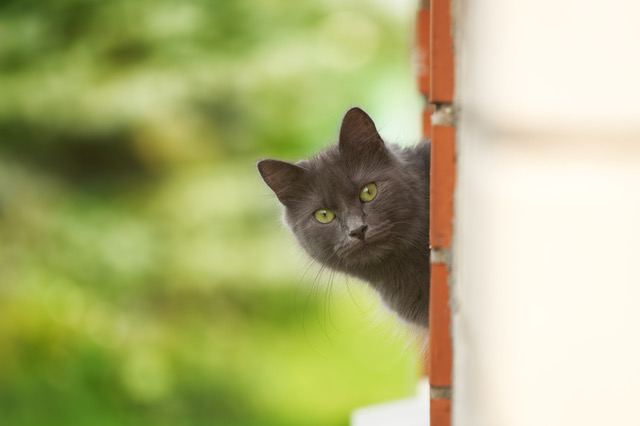
No one wants to lose their beloved feline family member… but, it does happen. Whenever I see signs on telephone poles or postings online for lost cats, my heart goes out to the families. For all us cat lovers, it’s like every lost cat is our own. The all-consuming worry, anxiety, and lost sleep can wreak havoc on our hearts and wellbeing.
I want to share some resources for retrieving lost cats, including step-by-step tips from lost pet expert Annalisa Berns, how to use the power of scent to attract your cat, and ways to prevent cats from going missing in the first place. This information can help you, a friend, or neighbor avoid the stress of losing a cherished feline family member.
Nextdoor and other lost-pet listings
One of the quickest ways to let your neighbors know your cat is missing is through Nextdoor, a neighborhood online forum where you can post a photo of your missing cat and your contact information. If someone in your neighborhood finds your cat, they can scan the lost pet listings to find you or they can create a post that they’ve found a lost cat. (I recently rescued a frantic dog on the loose in my neighborhood and through postings on Nextdoor, the dog and his owner were happily reunited within a couple hours).
In addition to Nextdoor, some other places that typically allow listings of lost pets include:
- Facebook neighborhood or lost-pet groups (find one near you)
- Craigslist (Lost and Found or Pets lists)
- Local shelters
- Animal control and more

Cat-loss Prevention
When it comes down to it, prevention is critical. Luckily, there’s so much we can do to prevent our cats from ever going missing!
1. Reduce the chances of your indoor cat getting out.
Our quick and stealthy feline family members can’t help but be curious. It’s in their nature. The sights and smells of the outdoors are intriguing. Is it any wonder they take advantage of open windows and doors?
Indoor cats can slip outside by door dashing or exiting through open windows and loose screens. And visitors and contractors can leave a door open or ajar just a moment too long. All of these scenarios can lead to a potentially heartbreaking outcome. Check your screens often and place a reminder sign on your doors to keep your cat indoors.
To release your indoor cat’s pent up energy and desire for fresh air and the stimulation of the outdoors, leash walking, pet strollers and catios, outdoor “cat patios” are great preventative measures to keep your cat safe. (Read about two now-reformed door dashing cats from two separate homes who fell in love with their catios.)
2. Give free-roaming indoor/outdoor cats a safe, outdoor experience.
The risk of getting lost or hurt is even greater for indoor-outdoor cats. Cats who roam freely outdoors are at risk from vehicles, predators, poisons, diseases from other animals, pesticides, getting lost or locked in a neighbor’s garage. Plus, expensive vet bills. An outdoor cat enclosure can provide a safe alternative for the indoor/outdoor dilemma and provide peace of mind knowing your cats is always safe.
But what if your cat becomes lost?

Cat In Bushes Lost Cat Blog
Recently, I connected with lost pet expert and owner of Pet Search and Rescue, Annalisa Berns. A passionate and dedicated Search-Dog Handler and Licensed Private Investigator in California, she agrees that prevention is the best method to keep your pet safe.
Annalisa also cautions about microchips. They are nothing like GPS and can’t guarantee your pet will be found. However, they are useful if someone finds a lost pet. The chip can be scanned and the parent and pet can be reunited.
I asked Annalisa, the pet detective, a few questions to help find a lost cat.
Q: What should someone do in the first minutes after their cat is missing?
A: If your cat just went missing, you want to start with a physical search inside your home or where your pet went missing from. If you have an indoor only cat, make sure to check inside cabinets, drawers, and closets. Keep outside doors and windows closed so your cat doesn’t get out, if they are still safe inside.
Q: What about in the first hours?
A: After you search inside your home, expand your search area to outside your home and also the surrounding areas. Start with a 3-home (or building) radius from your location. That means physically searching the outside of your home and 3 homes in each direction, including behind your property and across the street. Pay special attention to hiding spots like crawl spaces, open garages, under decks and junk. Search closely for hiding spots, but also evidence of your cat like fur. Make your neighbors aware that your cat is missing and make sure they have your phone number and know to call you if they see your cat, no matter the time of day. It is a good idea to write down your neighbor’s phone numbers also.
Q: By the end of the first day?
A: If you don’t find your lost cat quickly, it is time to ask for help. Ask a friend, neighbor or family member to help in the search. Using supplies around your home, make some giant signs. They can be made on a large piece of cardboard, a scrap piece of wood, or anything else that might work. Include the text “LOST CAT” and your phone number. Post this sign out where neighbors will see as they drive in and out of the neighborhood.
Use a flashlight, or if possible, a more powerful spotlight, to go back to hiding spots and look for eyeshine (the reflection of your cat’s eye.) If it is nighttime and you haven’t found your cat yet, you should make sure to leave a safe way for your cat to come home on its own overnight. For example, a garage door cracked open. The ideal would be to leave the way the pet got out open so they can return that way, but only if it is safe. If you have other pets, it is critical to keep the other pets safe too. Once it gets dark, another search should be conducted with a flashlight or spotlight in the area looking for eyeshine.
Q: Is there a difference where indoor-only cats will go if they get out?
A: For indoor only cats, they are most likely to be found hiding nearby. It is critical to do a close physical search inside and outside of where they went missing, and the surrounding properties. They can get into tiny hiding spots, so look closely at any hiding spots.
Q: If your cat won’t respond to your voice calls, are there other things you can do to encourage them to reveal themselves?
A: When cats go missing, they often “hide in silence,” a term coined by Kat Albrecht of Missing Animal Response. This is when a cat is too afraid to break cover, even when their owner is calling for them. It is a survival tactic that helps keep a cat safe. However, it can make it very hard to find a lost pet. The most important thing is to be persistent in your search efforts and not give up – even if your cat isn’t responding to your calls. One tip is not to scream for your pet in a panic-stricken voice. If you call for your cat, try a happy or normal voice. You can also try sounds that are familiar to your cat, like opening a cat food can, or shaking kibble in a dish.

Q: If a cat is constantly escaping, what do you recommend to help keep them safe?
A: Management is the best option for keeping your cat safe. Several proactive management tools to consider include:
- Build a catio, an outdoor enclosure, so cats can have safe access outside. Create a fun and interactive environment. Safe outdoor enrichment can help reduce your cat’s wanderlust.
- Install a security door or screen door on a spring so it closes quickly behind you, so your cat can’t slip out.
- Install double doors at every exit point, for example, a baby gate before the front door, or a gate on the front porch (to slow your cat down if they do get out.)
- Check window screens regularly, and replace any with damage or holes. Install security cameras with motion sensor activation that notifies you of movement outside so you know right away if your cat got out.
- Get pet GPS for your pet if they are an escape artist.
- Introduce yourself to your neighbors and provide them with your phone number and a description of your pet, letting your neighbors know your pet is an escape artist and to call you right away if they see your pet.
Check out a list of more resources Annalisa recommends to keep pets safely at home.
How to attract your cat to return home
Mia Dravis, a cat parent in California, offers additional tips for using the power of scent to attract your missing cat:

Sometimes cats lose their sense of direction and familiar scents can help bring them back home. Pour some of the kitty’s dirty litter on the lawn, or put the whole litter box outside the front or back door as their own scent can bring them back. However, If you have coyotes or predators in the area, this is not advised.
Also, you can use blankets, clothes, bedding, or pillows that have your scent and place them on the lawn or in front of your door, whether you live in an apartment or house.
You can also put out their favorite food in a cat trap. That way if they are just playing around or roaming, your cat will smell the food, eat, and be safely trapped.
Ultimately, prevention is the best first step.
See how the parent of a door dasher resolved the stress of worrying about his cat’s safety.
Catios are a growing trend for feline enrichment and safety. They can be a purrfect solution if you have a cat that loves the outdoors and will do anything to experience fresh air, birdwatching, and the wind in their whiskers.
There are many benefits of catios and resources available to keep your cat safe, healthy and happy – including custom catios and DIY Catio Plans for a window, deck, patio, or yard. Consider building a catio to satisfy your indoor cat’s curiosity… and to protect your indoor/outdoor cat from harm. You’ll enjoy peace of mind knowing your cat is always safe while also protecting birds and wildlife.
Is it time for a catio?

LEARN MORE ABOUT DIY CATIOS >>>

 Cynthia Chomos is a
Cynthia Chomos is a 
